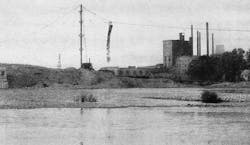Historic Slackline Cableway Excavator
Introduced in 1911, the Sauerman Bros. Slackline Cableway Excavator gained acceptance from contractors, engineers, and aggregate producers for four main reasons: It excavated to great depth equally well in dry ground or under water; it conveyed the spoil over a great distance; it elevated the spoil to the hopper or spoil bank; and because one simple machine with one operator performed all this work.
The text and image for this article are adapted from two Sauerman Bros. catalogs, Excavating for Profit (No. 9, 1926) and Power Drag Scrapers (No. 14, 1931), in the HCEA Archives.
More historical construction equipment here.
The Slackline Cableway Excavator was primarily a long-range machine, and was at its best working to considerable depths and conveying at least 200 feet to an elevated dumping point. The most efficient operating span between the mast and ground anchorages varied with machine capacity; the smallest, with a 1/3-yard bucket, worked most economically at about 300 feet, and the top of the line 3-1/2 yarder worked at lowest cost per yard at up to 1,200 feet.
At times these ideal ranges had to be exceeded due to ground conditions and obstructions such as rivers. Maximum effective digging depth was one-third the operating span, meaning it could dig far deeper than was ever normally required. It would elevate the load as high as the top of the mast. Many aggregate producers used it to reach material 80 to 100 feet underwater and lift it 100 feet above the water’s surface to a hopper at the edge of the pit. It would dig any material that could be turned by an ordinary plow.
Working to 100 feet deep with a 1,200-foot span, a single rig could excavate over 6 million cubic yards in a full circle around the mast by moving the tail tower around the perimeter of the area being excavated and, after 180 degrees of such motion, relocating the mast’s guys and changing the positions of the blocks to give access to the other 180 degrees.
These excavators normally had a wood or steel mast 50 to 125 feet high set upon a concrete foundation, although other headworks were also available. It was secured by four main guy cables and two lighter auxiliary guys. A double-drum power unit, set on another concrete slab at a distance of about 1 1/2 times the mast height, operated the bucket and carrier. Two single-sheave guide blocks and two tension blocks were atop the mast.
The number of sheaves on the tension blocks depended on the installation’s requirements. Three blocks were attached to the mast: One tension block at the top; beneath it, one guide block for the tension line; and beneath that, the other guide block, for the load line. The other tension block was held in place by the tension line, which ran from the hoist’s rear drum through the two tension blocks and the tension guide block.
The Historical Construction Equipment Association (HCEA) is a 501(c)3 nonprofit organization dedicated to preserving the history of the construction, dredging and surface mining equipment industries. With over 3,800 members in 25 countries, our activities include publication of a quarterly educational magazine, Equipment Echoes, from which this article is adapted; operation of National Construction Equipment Museum and archives in Bowling Green, Ohio; and hosting an annual working exhibition of restored construction equipment. Our 2020 show has been postponed to August 27-29, 2021, near Concordia, Kansas. Individual annual memberships are $35.00 within the U.S. We seek to develop relationships in the equipment manufacturing industry, and we offer a college scholarship for engineering and construction management students. Information is available at www.hcea.net, or by calling 419.352.5616, or emailing [email protected].
